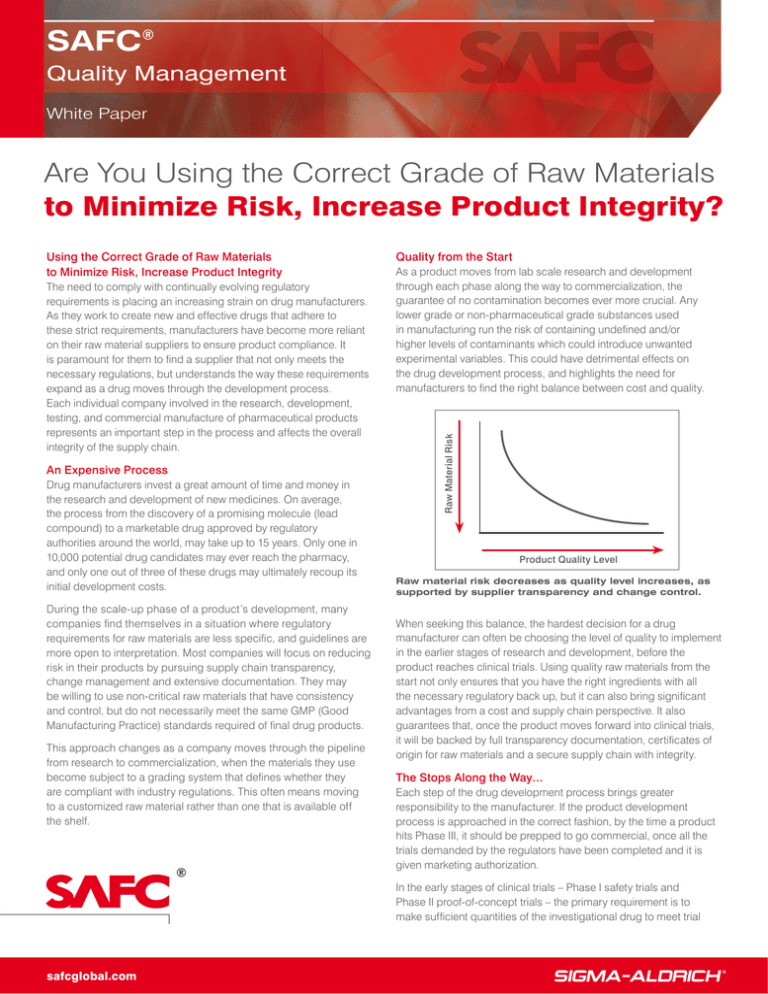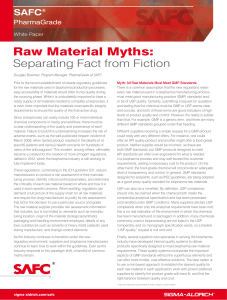
SAFC®
Quality Management
White Paper
Are You Using the Correct Grade of Raw Materials
to Minimize Risk, Increase Product Integrity?
The need to comply with continually evolving regulatory
requirements is placing an increasing strain on drug manufacturers.
As they work to create new and effective drugs that adhere to
these strict requirements, manufacturers have become more reliant
on their raw material suppliers to ensure product compliance. It
is paramount for them to find a supplier that not only meets the
necessary regulations, but understands the way these requirements
expand as a drug moves through the development process.
Each individual company involved in the research, development,
testing, and commercial manufacture of pharmaceutical products
represents an important step in the process and affects the overall
integrity of the supply chain.
An Expensive Process
Drug manufacturers invest a great amount of time and money in
the research and development of new medicines. On average,
the process from the discovery of a promising molecule (lead
compound) to a marketable drug approved by regulatory
authorities around the world, may take up to 15 years. Only one in
10,000 potential drug candidates may ever reach the pharmacy,
and only one out of three of these drugs may ultimately recoup its
initial development costs.
During the scale-up phase of a product’s development, many
companies find themselves in a situation where regulatory
requirements for raw materials are less specific, and guidelines are
more open to interpretation. Most companies will focus on reducing
risk in their products by pursuing supply chain transparency,
change management and extensive documentation. They may
be willing to use non-critical raw materials that have consistency
and control, but do not necessarily meet the same GMP (Good
Manufacturing Practice) standards required of final drug products.
This approach changes as a company moves through the pipeline
from research to commercialization, when the materials they use
become subject to a grading system that defines whether they
are compliant with industry regulations. This often means moving
to a customized raw material rather than one that is available off
the shelf.
Quality from the Start
As a product moves from lab scale research and development
through each phase along the way to commercialization, the
guarantee of no contamination becomes ever more crucial. Any
lower grade or non-pharmaceutical grade substances used
in manufacturing run the risk of containing undefined and/or
higher levels of contaminants which could introduce unwanted
experimental variables. This could have detrimental effects on
the drug development process, and highlights the need for
manufacturers to find the right balance between cost and quality.
Raw Material Risk
Using the Correct Grade of Raw Materials
to Minimize Risk, Increase Product Integrity
Product Quality Level
Raw material risk decreases as quality level increases, as
supported by supplier transparency and change control.
When seeking this balance, the hardest decision for a drug
manufacturer can often be choosing the level of quality to implement
in the earlier stages of research and development, before the
product reaches clinical trials. Using quality raw materials from the
start not only ensures that you have the right ingredients with all
the necessary regulatory back up, but it can also bring significant
advantages from a cost and supply chain perspective. It also
guarantees that, once the product moves forward into clinical trials,
it will be backed by full transparency documentation, certificates of
origin for raw materials and a secure supply chain with integrity.
The Stops Along the Way…
Each step of the drug development process brings greater
responsibility to the manufacturer. If the product development
process is approached in the correct fashion, by the time a product
hits Phase III, it should be prepped to go commercial, once all the
trials demanded by the regulators have been completed and it is
given marketing authorization.
In the early stages of clinical trials – Phase I safety trials and
Phase II proof-of-concept trials – the primary requirement is to
make sufficient quantities of the investigational drug to meet trial
safcglobal.com
SAFC®
Quality Management
White Paper
needs. When it moves on to the large-scale Phase III trials, the
key factor is the ability to transition from small-scale clinical to
large-scale commercial manufacturing. This is often the point where
a manufacturer will switch the clinical batch manufacturing process
from liquid to powdered media, and lock down any remaining
regulatory aspects of the commercial manufacturing process.
Once the drug is approved, it becomes available to patients, with
on-going Phase IV monitoring for unforeseen side-effects that only
become apparent when it is used in much larger patient populations.
On the manufacturing side, the focus shifts to supply chain
management and timely delivery, focusing on improving the yield,
CAPA (corrective and preventative action) plan development and
managing key suppliers. The biggest concerns include changing
formulations and/or dose regimens, for example developing
extended release formulations, and applying for label extensions to
enable the drug to be prescribed for additional indications.
What to Look for from a Supplier
Raw materials sourced for use in commercial products must
be manufactured in a way that meets the requirements of the
biopharmaceutical regulated manufacturing process. Drug
manufacturers should look to work with a supplier that offers
classified products, from non-regulated, non-GMP raw materials to
highly regulated GMP products; the breadth of offering will serve to
ease transitions through each development phase.
When seeking a supplier, it is important to verify that they offer an
optimized supply chain and issue resolution, as well as being able
to help develop risk mitigation strategies and even look to provide
assistance with shortening timelines in development programs.
Other important factors include:
Process Control – Qualified suppliers will have top-of-the-line
facilities that are equipped with the latest technologies. This allows
them to manufacture quality products consistently that are reliably
free of contaminants. Additionally, this allows the supplier to offer
clear documentation for each product, to ensure full disclosure to
the client.
Regulatory Support – With an increasingly strict regulatory
environment, and one that can vary geographically, it is imperative
that a supplier understands the regulations, and also works to stay
updated on any new developments. In other words, the supplier
should stay ahead of the regulations so manufacturers are not
burdened with the lengthy research that would otherwise be
needed to ensure full regulatory compliance for each step of the
development process.
Supply Chain Information – It is not enough to simply have a
strong supply chain. A good supplier will be able to validate this
supply chain with full documentation and transparency to ensure
access to the ingredients as soon as they are needed. The supplier
should provide guidelines on the appropriate quality level for each
application, and provide an understanding of the implications of
that decision.
Supply Chain Control – In an increasingly global market, being
able to access supplies of necessary raw materials, and having a fall
back for where they come from, is crucial. A secured supply chain,
with redundant facilities in different locations, allows a supplier to
guarantee the availability of its products, even when disaster strikes.
In addition, it is imperative that a supplier has a change control
notification program to keep customers constantly informed of any
changes in the raw materials supply.
SAFC’s Approach
SAFC, a member of the Sigma-Aldrich family, is dedicated to solving
manufacturing challenges by providing customers with tailored
quality and regulatory support for product applications. SAFC
classifies the majority of the Sigma-Aldrich products under one of the
four levels of the Enhanced Quality Program, from the non-regulated,
non-GMP raw materials to highly-regulated GMP products.
Each level has associated quality support and documentation, along
with recommended use and change notification parameters. By
differentiating the products, SAFC helps take the guesswork out of
the process. The PharmaGrade products provide clearly defined and
classified raw materials for use in development.
Regardless of the tier of product sourced, SAFC is able to offer
support throughout development. From the ability to offer products
as readily available inventory to maximize time, to offering scientists,
researchers and manufacturing specialists whom are able to provide
insight into the appropriate grade of raw materials for each step,
SAFC is capable of providing the resources needed along the way.
All of this is further supported by the appropriate documentation,
required by the regulators, that corresponds to the specified
manufacturing requirements in each stage – from discovery to
development and from clinical trials to commercialization.
Encompassing a dynamic product list of raw materials, supplements,
buffers, enzymes and other products used in biopharmaceutical,
pharmaceutical and diagnostic applications, SAFC has the
capabilities to match the appropriate level of service that a
manufacturer’s risk mitigation needs call for.
To learn more about SAFC’s Enhanced Quality Program, please visit:
safcglobal.com/enhancedquality
To learn more about SAFC’s high quality product line, PharmaGrade,
please visit: safcglobal.com/pharmagrade
PFW
80098-512160
1122
safcglobal.com
©2013 Sigma-Aldrich Co. LLO. All rights reserved. SAFC and SIGMA-ALDRICH are trademarks of Sigma-Aldrich Co. LLC, registered in the US
and other countries. Purchaser must determine the suitability of the product(s) for their particular use. Additional terms and conditions may apply.
Please see product information on the SAFC website at www.safcglobal.com and/or on the reverse side of the invoice or packing slip.




